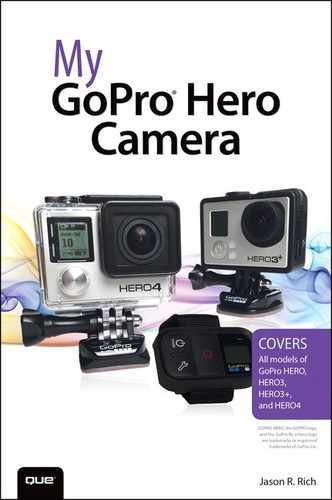6. Choosing the Best Memory Cards for Your GoPro Camera

In this chapter, you learn all about microSD memory cards and how to use them with your GoPro camera. Topics include the following:
![]() Selecting the best microSD memory cards for your needs
Selecting the best microSD memory cards for your needs
![]() What you should know about memory card capacity and read/write speeds
What you should know about memory card capacity and read/write speeds
![]() Inserting the memory card into your camera and using it
Inserting the memory card into your camera and using it
![]() How to format and manage your memory cards
How to format and manage your memory cards
As with any point-and-shoot, digital SLR or digital video camera, the photos and video you shoot are stored within a removable memory card that you insert into the camera prior to shooting.
Dozens of different memory card formats are available. Each memory card format comes in a variety of different capacities, and each offers a specific read/write speed. You need to choose the right memory card for your GoPro camera because this is one piece of required equipment that does not come bundled with the camera.
All the GoPro camera models use a tiny-sized microSD format memory card. This makes shopping for memory cards a bit less confusing. However, you still have some important decisions to make that relate to the card’s read/write speed and storage capacity.
The microSD Memory Card Stores Your Images and Video
Your camera’s memory card is meant to be a temporary storage solution for your photos or videos. Ultimately, you need to transfer your content from the camera’s memory card to your computer, mobile device, and an online-based service to view, edit, archive, and potentially share your content. Then, you can reformat (erase) the memory card and reuse it.
Picking the Right Memory Card Speed Class
A memory card’s speed class is rated and measured based on how quickly data can be transfered from your camera and stored onto the memory card while you shoot. This is the memory card’s write speed.
To record high-definition or ultra high-definition (4K resolution) video, or high-resolution digital photos, a lot of information needs to be transferred between your camera and the memory card quickly while you actually shoot. Thus, for a microSD memory card to work with your GoPro camera, it must record (write) data fast enough to keep up with the camera.
Be sure to select a microSD memory card that has a Class 10 or UHS-1 rating, which displays on the memory card’s packaging, and often on the memory card. The speed class of a Class 10 memory card can often be identified with the number 10 within a circle.
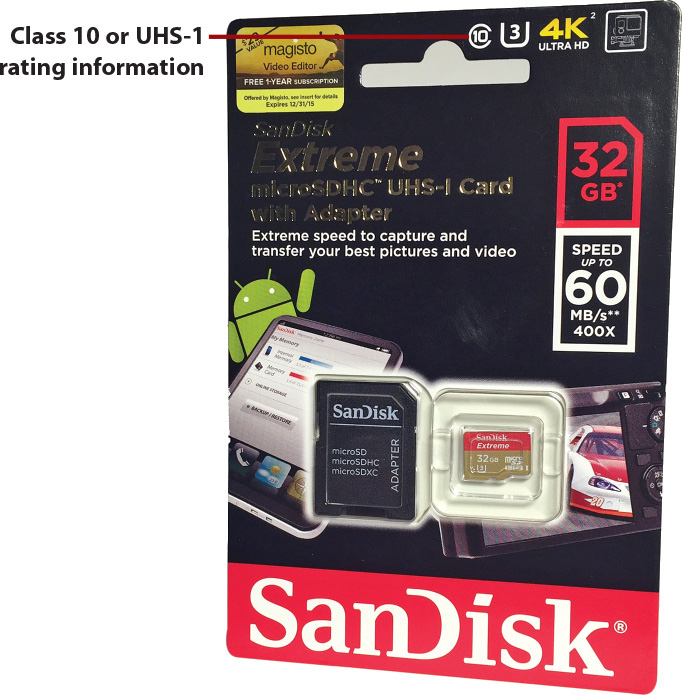
For microSD memory cards, companies use different types of flash memory during the manufacturing process. The Class rating of a memory card refers to its write speed. The UHS Speed Class is another measure of a memory card’s write speed. A microSD memory card with a UHS-1 rating has a minimum write speed of 10MB/second, which is needed to store HD or Ultra HD digital video files.
Meanwhile the read speed of a microSD memory card refers to how quickly data that’s stored within the card (in this case, your photo or digital video files) can be transferred from the card to your computer. This also is measured in megabytes (MB) per second.
As you shop for microSD memory cards for your GoPro camera, choose the cards with the fastest read/write speed (that is Class 10 or UHS-1) rating you can afford. Traditionally, the higher the card’s read/write speed, the higher the price of the card. However, due to intense competition among memory card manufacturers, this is not always the case.
Selecting a Memory Card’s Storage Capacity
Every memory card has a maximum storage capacity, which can be 4, 8, 16, 32, or 64 gigabytes (GB). Obviously, the larger the storage capacity of the card, the more photos and video it can hold. Although microSD memory cards come in capacities larger than 64GB, this is the highest capacity your GoPro camera is currently compatible with.
A Memory Card’s Capacity Is Important
One of the major contributing factors to a memory card’s price is its capacity. So, in general, choose a card with the highest storage capacity and fastest read/write speed you can afford. If you plan to shoot HD or Ultra HD video, you need a microSD card with a 32GB or 64GB capacity because anything smaller fills up too quickly.
The number of photo files or the length of HD or Ultra HD video that can fit on a particular size memory card varies greatly based on many factors, including the resolution and frame rate at which you capture the video, or the resolution and field of view you use to capture digital images. If you use certain camera features, such as Protune, this generates larger file sizes, which ultimately require more memory card storage space. In addition, file sizes associated with 4K video shot at 15fps on a Hero4, for example, are massive.
As you shoot photos and video, your camera’s Status Screen displays how many additional photos, or how much more video the memory card can hold based on its current settings.
If you change any of the camera’s settings, you increase or decrease the shooting resolution, which impacts the number of additional photos or how much additional video the memory card can hold. This same information displays on the Smart Remote’s Status Screen or within the GoPro mobile app as you shoot.
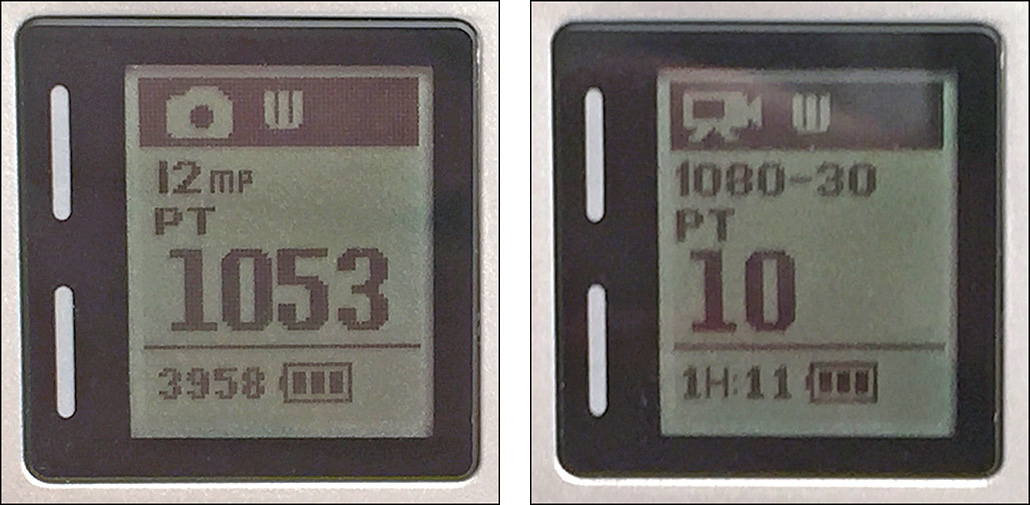
Shown on the left, the Hero4 is set to Photo mode. The memory card within the camera has 1,053 images already stored within it and the capacity to hold 3,958 additional images.
On the right, the Hero4 is set to Video mode. The memory card has 10 videos stored within it. Based on the camera’s current settings, and what’s already stored on the memory card, it can hold up to 1 hour and 11 minutes (01:11) of additional video content.
Shopping for and Using microSD Memory Cards
You can purchase microSD memory cards that are compatible with your GoPro directly from GoPro’s website (www.GoPro.com). However, GoPro has opted to offer only 32GB and 64GB memory cards manufactured by SanDisk and Lexar, for $49.99 (32GB) and $79.99 (64GB). These are excellent memory cards, but you do have other options, including finding these same memory cards at lower prices from consumer electronic stores, office supply superstores, and any specialty camera store, including a wide range of online merchants.
Your must determine your needs and then shop for the best prices. However, you’ll always pay a hefty premium if you’re on vacation and wait to purchase a new memory card at or near a popular tourist destination.
Amazon.com offers microSD memory cards from many different manufacturers at competitive prices. However, you can also use a price comparison website, such as Nextag (www.nextag.com), and within the Search field, type exactly what you’re looking for. Your search results will display dozens, possibly hundreds, of online merchants that offer microSD memory cards at the discounted prices they’re offering them at, as well as merchants’ reviews from customers.
What to Search for Online
Within the Search field of Amazon.com or Nextag.com, for example, use a search phrase such as, “microSD memory card, 32GB.” If you’re looking for memory cards from a specific manufacturer, also include this within your search. For example, enter, “SanDisk microSD memory card, 64GB” into the Search field.
Brand name memory cards often cost more than generic memory cards that are usually technologically identical to their brand name counterparts. As long as you use a microSD memory card that’s Class 10 and UHS-1 rated, which have a 64GB (or less) capacity, it should work fine with your camera. However, GoPro recommends using a name brand memory card that has been tested for maximum reliability when shooting and engaging in high-vibration activities and when the camera is used in extremely hot, humid, or cold temperatures.
Insert a Memory Card into Your Camera
When you have a new microSD memory card, turn off your GoPro camera and remove it from its housing and mount. As you handle the camera, avoid directly touching the lens with your fingers or palms. You should insert or remove your camera’s memory card indoors in a clean and dry environment. Follow these steps for inserting the memory card:
1. Remove the port door on the side of your camera. Be careful you don’t accidentally lose this small plastic door.
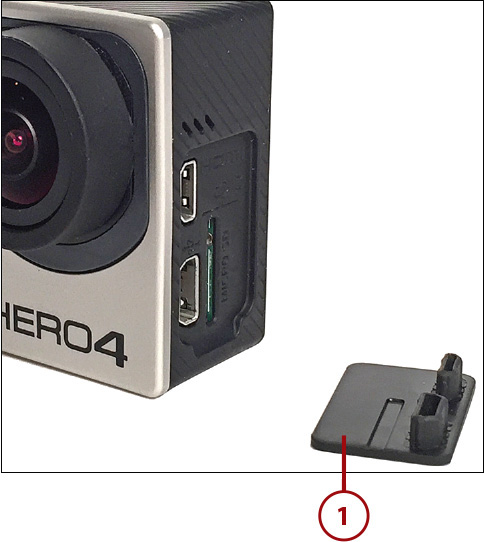
2. Holding the memory card with your thumb and index finger, gently place it partway into the camera’s microSD memory card slot, with the front of the memory card facing forward toward the front of the camera. If the memory card doesn’t slide into the card slot easily, you may have it backward or upside down.
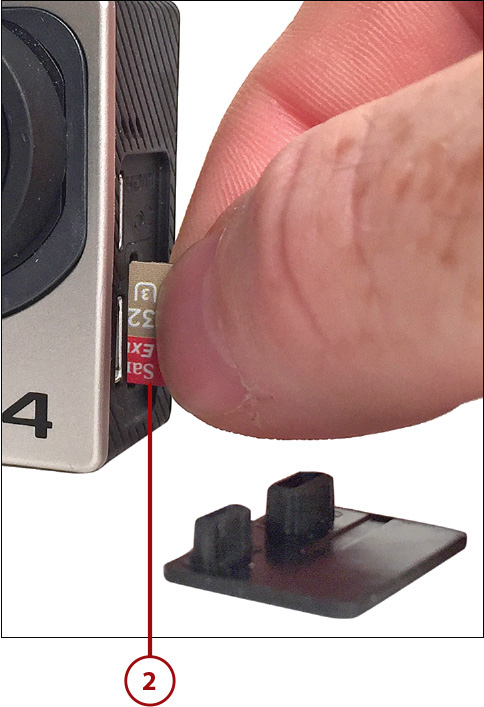
Safety Tip
When removing the memory card from its packaging, avoid touching the metallic connectors on the card with your fingers. It’s essential that these connectors are kept clean.
3. Using one finger, press the side of the card so that it gets fully inserted into the camera’s memory card slot.
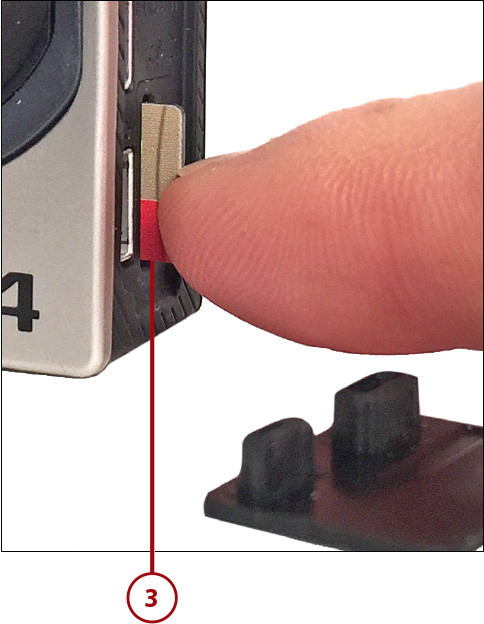
4. It should click into place and remain flush with the camera’s card slot. Replace the port door on the camera.

Removing a Memory Card from the Camera
To later remove the memory card, simply place your finger against the end of the card and press gently inward to unlock the card from its locked position. Then gently remove the card with your fingers.
Format a microSD Memory Card Using a Hero4
Prior to initially using a new memory card, or after you transfer a memory card’s content from the card to your computer, mobile device, or an online service, you need to format or reformat the memory card while it’s installed within the camera. To format (or reformat) your Hero4’s memory card, follow these steps:
1. With the memory card installed in the camera and the camera turned on, repeatedly press the Power/Mode button to scroll through the menu options until the Setup (gear-shaped icon) appears on the camera’s Status Screen.
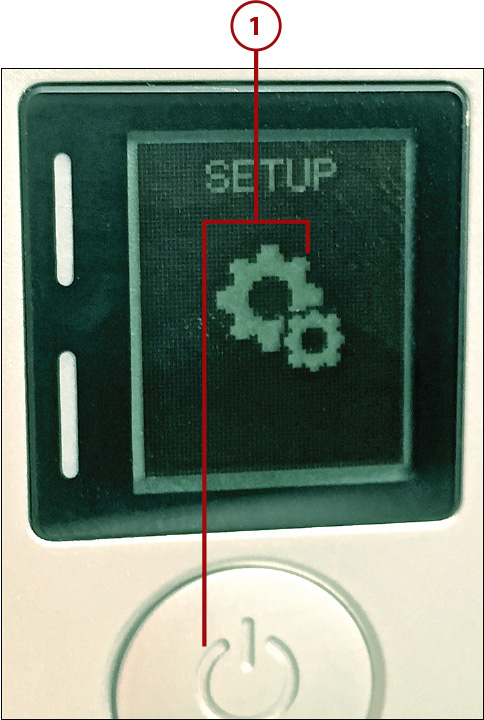
2. Press the Shutter/Select button to access the Setup menu.
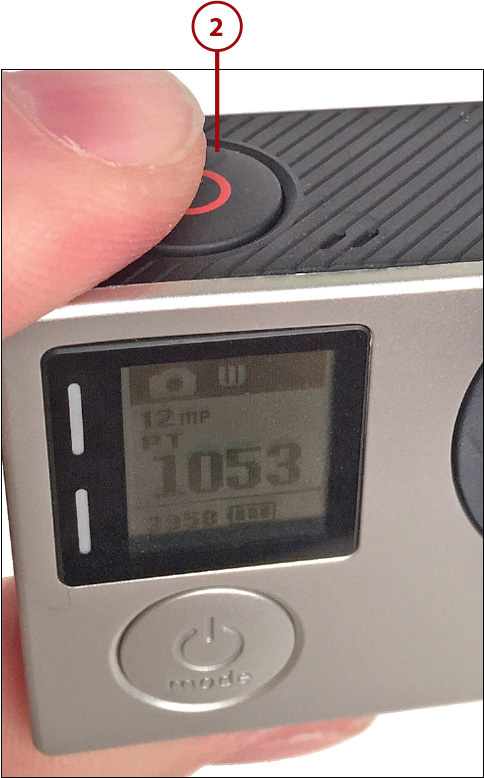
3. Repeatedly press the Power/Mode button to scroll through the Setup menu options until the Trash icon appears on the camera’s Status Screen. Press the Shutter/Select button to choose this option.

4. Press the Power/Mode button repeatedly until the ALL/Format option displays. Then press the Shutter/Select button to choose it.
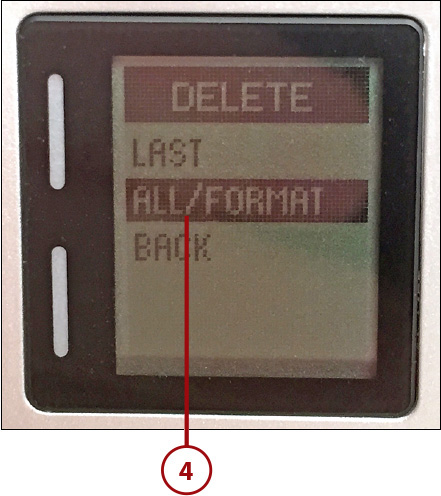
5. Press the Power/Mode button repeatedly until the Delete option displays; then press the Shutter/Select button to choose it.
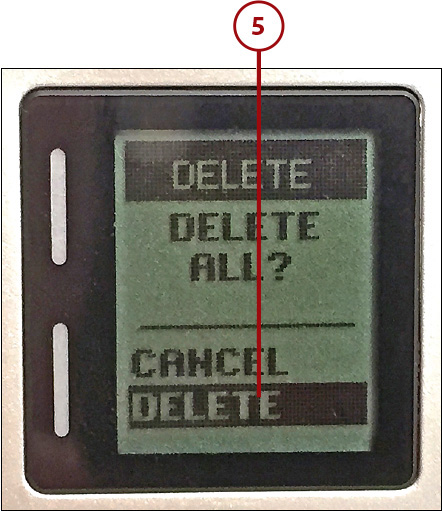
6. The camera’s red Status Lights illuminate to indicate the formatting process is underway. Depending on the capacity of the memory card, formatting or reformatting takes between 5 and 15 seconds.
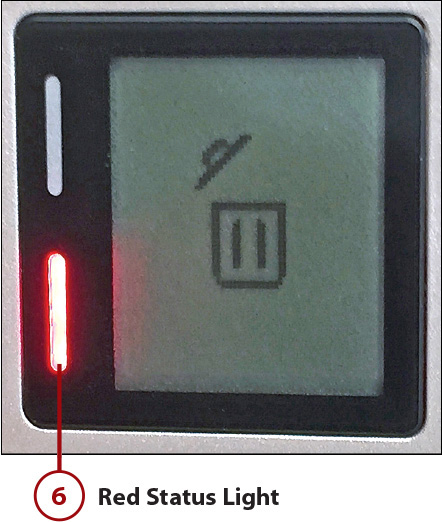
When the format is complete, the camera’s memory card is now empty. When the camera is turned on, the file counter should say zero. Before attempting to shoot anything, snap one test photo and preview it to ensure the memory card functions properly.
Formatting a Memory Card Using a Hero3+
Formatting a memory card permanently deletes all content that’s stored on it. You can find directions for formatting a microSD memory card using a Hero3+ on GoPro’s website (http://gopro.com/support/articles/formatting-sd-card-with-hero3).
Understanding Memory Card-Related Error Messages
Your GoPro camera can generate three error messages related to memory cards. If necessary, one of these messages will display on the camera’s Status Screen.
• The NO SD message means there is no memory card present within the camera’s microSD memory card slot. Simply insert a memory card into the camera to rectify this situation.
• The word Full will display if the memory card’s capacity has been reached. At this point, you need to delete files or replace the memory card.
• The SD ERR message means some type of data-related error has occurred. Perhaps the data on the card has been corrupted. To fix this, you’ll often need to reformat the card, which will delete all its contents.
What to Do
When you see an SD ERR message (which rarely, if ever happens), turn off the camera immediately and remove the memory card from the camera. By connecting the memory card to your computer (via a memory card reader) and using specialized data recovery software, you might retrieve any photos or videos already stored on the card before reformatting it. This is also something a professional data recovery service can do for you, but this is typically a costly option.
